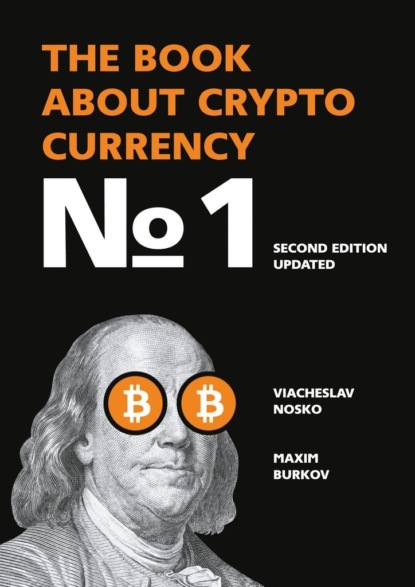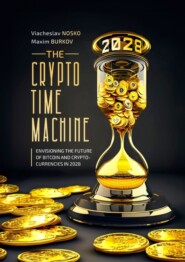По всем вопросам обращайтесь на: info@litportal.ru
(©) 2003-2024.
✖
The Book about Cryptocurrency №1. Second edition expanded
Настройки чтения
Размер шрифта
Высота строк
Поля
All data in the Blockchain network is recorded in blocks that are linked to each other.
All transactions take place in the blockchain. Each transaction is written to a block and cannot be changed anymore. In order to form a new block, certain calculations must be done. That computer, which has managed to do the task, receives its reward in bitcoins. This process is called mining, and accordingly, the owners of the computers that do the calculations are miners.
The more miners there are in the world, the faster the transactions can go and the more stable the whole system is.
What is Bitcoin? It is essentially the name of a network that began operating in 2009 and which utilized Blockchain technology.
To break these concepts down, let’s define it once again:
Blockchain is a technology that can be applied to more than just cryptocurrencies; bitcoin is a cryptocurrency, the first cryptocurrency, the progenitor of all other coins and by far the most valuable of currencies.
The term «cryptocurrency» gained traction in 2011 thanks to a Forbes magazine article on Bitcoin. Subsequently, the term «cryptocurrency» began to refer to any crypto-money.
The word Bitcoin is formed from two English words: bit – unit of information and coin – coin. The literal translation into Russian is «minimal coin».
It is the first most expensive and has the largest capitalization today cryptocurrency.
The purpose of bitcoin is to create a universal global decentralized payment system that is not under the control of banks, governments and other intermediaries. Bitcoin, like other cryptocurrencies, helps to make p2p (person to person) payments.
The pros of bitcoin compared to traditional (fiat) currencies are:
● A bitcoin account can never be blocked by anyone. These are your funds forever. Only on the condition that you follow digital security techniques. We’ll talk more about security techniques later. And more than once.
● Account transactions are both anonymous and transparent. The list of transactions can be tracked in a publicly available log. It is not known who sent the money and to whom.
Unlike a classic bank account, a cryptocurrency account is not tied to personal data.
But not everything is so rosy. Bitcoin and other cryptocurrencies also have disadvantages:
● If you make a mistake with your wallet number (it’s not hard to make a mistake here – the ID of each wallet consists of 34 characters, including numbers, lowercase and uppercase letters and other characters), it will be impossible to cancel the transaction. Attention and thoroughness are the keys to success in working with cryptocurrency.
The cryptocurrency market is highly volatile due to its rapid growth and the nature of cryptocurrencies themselves. (Volatility is the level of price changes in the market. High volatility is when the price can change significantly in a short period of time). This is why inexperienced and novice crypto traders lose money, because it is very difficult to predict how the market will behave in the coming months.
If your wallet has been hacked or lost, if you have forgotten the password or passphrase of your wallet, it is impossible to get back the lost funds.
How is blockchain better than a database?
This question was answered comprehensively and succinctly by Matthew Chan, entrepreneur, designer, cryptocurrency enthusiast, and creator of MatrixPortfolio.com, a mobile app for crypto investors.
The original article was published on Hacker Noon, translation on our portal https://pro-blockchain.com (https://pro-blockchain.com/).
I want to convince you why blockchain is necessary, why we need to motivate people to pursue decentralization and its benefits, and why tokens are needed and what underlies their value. Now that the cryptocurrency market is increasingly saturated, it is important for us to understand the underlying technologies and principles behind digital money, as this understanding will allow us to make smart investments and separate the important from the non-essential.
In fact, blockchain borrows a lot from game theory and motivational models. For a blockchain network to be valuable and/or useful, it must have participants. It will be useless if only you and I are blockchain users.
In order to attract participants, some form of motivation is required. The most common means of motivation is a reward in the form of a token. The more participants there are, the more decentralized the network becomes.
Why not just a database? Why do projects need blockchain?
A decentralized system has several advantages over a centralized server / database:
● immutability;
● security;
● backup;
● cost reduction;
● accountability and transparency.
Immutability
When data and records are decentralized and hosted on a blockchain, they are virtually impossible to falsify or change. If you store data on, say, a personal computer, you can easily alter a file before sending it to another person. How can you be trusted in this case?
Security
Traditional servers or data tend to be centralized, making them an attractive target for attacks. The Equifax security breaches and other recent cybersecurity issues are a case in point. A single server or a limited number of servers can easily fall victim to hackers, but decentralization through blockchain puts a serious damper on attackers. The more participants and nodes in the network, the more copies of data exist. Therefore, in order to modify data, it is necessary to attack every single node in the network and modify all the data at the same time. Blockchain not only serves as a defense against theft, but it has virtually no vulnerabilities. Each block on the chain contains a certain amount of data, and when that block gets full, like a USB flash drive, the data is encrypted and sealed forever. To get the whole picture, hackers would need to hack not only the current block, but every block preceding it. Not only is this nearly impossible technically, but it is also expensive. Thus, the incentive for criminal activity is reduced. I am now describing the concept in general: different blockchains use different security measures and algorithms.
Backup
If the dataset is distributed globally, you don’t have to worry about losing a single copy. Thanks to this, you can protect against corporations getting rid of data tampering, server failures, etc.
Cost reduction
A decentralized network of nodes supporting a registry helps companies reduce hosting, security and maintenance costs. In addition, decentralization saves on salaries for IT professionals, developers, and infrastructure managers. For example, Apple’s servers are literally under constant attack, forcing teams to monitor them 24 hours a day, 365 days a year.
Accountability and transparency
With the above in mind, you can rest assured that all information recorded on the blockchain is authentic. This allows one to do business in a transparent manner, freeing one from having to trust the opposite party. One can always turn to the blockchain, letting the data and facts speak for themselves.
Are today’s data infrastructures workable? Undoubtedly, but they are far from perfect. They worked as well as they could because there was no blockchain, a technology that enables significant improvements.
Okay, but what gives tokens value? Why are they in demand?
It depends on the project. 90% of all projects are worthless, but we’re going to talk about tokens that have real value and are actually applicable.
As I mentioned earlier, tokens are often used as a means of motivating network participants: a successful network implies many participants contributing to its decentralization and protection. The more participants there are, the more the network benefits. This is precisely the case of bitcoin. When Satoshi introduced it to the world, bitcoin had zero value. At that time, the only participant in the network was Satoshi himself. But now, as bitcoin becomes more widespread, people increasingly agree that the bitcoin token is useful as a currency and therefore has intrinsic value to the participants in the network.
In general, there are several classes of tokens, and each class has its own specific value.
Currency tokens: Bitcoin, Monero, Raiblocks, etc.
Utility tokens (utility tokens), which allow to perform some activity in the network, examples are ETH and ZRX. In the etherium network, ether is used for smart contracts.
Asset tokens, representing an actual asset or product.
Equity tokens (equity tokens), which function as securities. They give the right to vote and participate in decision-making.







